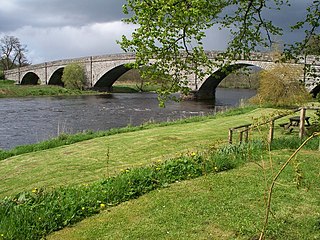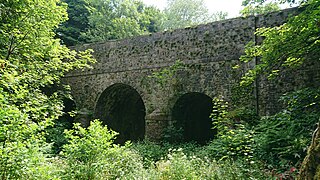
Closeburn Castle is a privately owned tower house, probably of the 14th century, but possibly older, and is one of the oldest continually inhabited houses in Scotland. The castle is located 1 km east of the village of Closeburn, in the historical county of Dumfriesshire, 2 km south-east of Thornhill, in Dumfries and Galloway, Scotland.

Carsluith Castle is a ruined tower house, dating largely to the 16th century. It is located beside Wigtown Bay in the historical county of Kirkcudbrightshire in Galloway, Scotland, around 4.8 kilometres (3.0 mi) south east of Creetown.

Balmaclellan is a small hillside village of stone houses with slate roofs in a fold of the Galloway hills in south-west Scotland. To the west, across the Ken River, the larger and more prosperous New Galloway lies below the Rhinns of Kells.

The Castle of Park is a 16th-century L-plan tower house near Glenluce, in the historic county of Wigtownshire in Dumfries and Galloway, Scotland. It is a category A listed building.

Torthorwald is a village and civil parish in Dumfries and Galloway, south-west Scotland. It is located 6 kilometres (3.7 mi) east of Dumfries on the A709 road to Lochmaben. The area was the property of the de Torthorwald family until the end of the 13th century, when the estate passed by marriage to the Kirkpatricks. In 1418, William de Carleil married the Kirkpatrick heiress. He may have been the builder of Torthorwald Castle, which was erected around this time, possibly on top of an earlier a motte. Torthorwald was erected as a burgh of barony in 1473. Torthorwald Castle was occupied until 1715; only two of its walls still stand, to a height of around 18 metres (59 ft).

Kirkandrews, sometimes written as Kirkanders in older documents, is a coastal hamlet about 9 kilometres (6 mi) west-southwest of Kirkcudbright in Dumfries and Galloway, Scotland. It sits in farmland at the head of Kirkandrews Bay, an inlet of Wigtown Bay.

Corseyard Farm, known locally as the Coo Palace and now marketed under that name, is an architecturally unusual dairy farm near Kirkandrews in Scotland, built between 1911 and 1914 and since converted into holiday accommodation. Erected for the Manchester businessman James Brown as part of a series of flamboyant improvements to the Knockbrex Estate, which he had bought in 1894, it was designed in the Gothic Revival style to resemble a fortified castle with battlemented roofs, arrowslit windows and arched entrances.

Anwoth Parish Church was built in 1826 to serve the parish of Anwoth in Dumfries and Galloway, Scotland. Designed by Walter Newall, it replaced Anwoth Old Church, which had been the parish church since it was built in 1626 and was partially demolished at the same time as the new church was built.
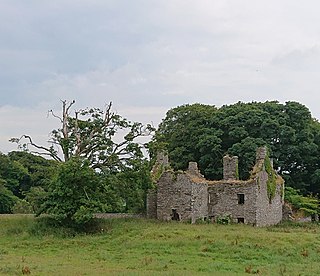
Borgue Old House is a ruined Y-plan house, about 300 metres (0.2 mi) east of Borgue in Dumfries and Galloway, Scotland. Built in 1680, but probably incorporating the fabric of an older building, its large main block has two projecting wings at either end of its south face; another wing in the middle of the north face probably contained the stairway, but this is no longer present. Each of the two main stories has three interconnecting rooms, on in each of the wings on the south face, and one in the main block. The main block would also have had an attic, but is now roofless.
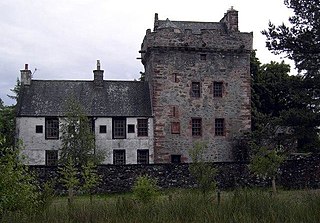
Hills Tower is a sixteenth-century square tower house, with an adjoining eighteenth-century wing, near Dumfries in Scotland. Originally built around 1527 for Edward Maxwell, who had purchased the estate from James Douglas of Drumlanrig, it was improved in the later sixteenth century by his grandson, also Edward Maxwell. In 1721, another Edward Maxwell had a two-storey Georgian wing added to the tower's east side, using stone taken from older buildings nearby, and incorporating armorial panels celebrating members of the Maxwell family.
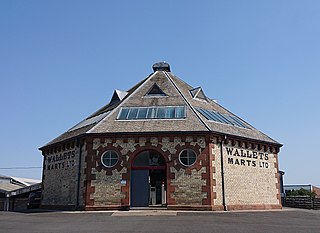

Girthon Old Parish Church is a ruined ecclesiastical building in Girthon, near Gatehouse of Fleet in Dumfries and Galloway. Built around 1620 on the foundations of a mediaeval church, and incorporating some of the fabric of the older building in its eastern and southern walls, it served as the parish church for Girthon until 1818 when a new church was built for the parish in Gatehouse of Fleet, after which it was abandoned and allowed to fall into disrepair. The church itself has been designated a scheduled monument, and the churchyard a Category A listed building.

Ardwall House is an eighteenth-century mansion near Gatehouse of Fleet in Dumfries and Galloway, Scotland. Built in 1762 for the McCullochs of Ardwall, it was extended in 1895 with the addition of pavilion wings to either side of the house. It was designated a Category A listed building in 1971. It is still in use, and remains in the hands of the McCulloch family.

The New Galloway Town Hall is a municipal building in Dumfries and Galloway, Scotland, situated on the town's high street. A tolbooth has existed on the site of the current building since at least 1711; in 1875, it was rebuilt and enlarged. In 1971 it was designated a Category B listed building.
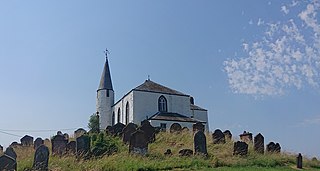
Crossmichael Parish Church is an ecclesiastical building in Crossmichael, Dumfries and Galloway, Scotland. It lies on a knoll, which was probably an ancient site of worship, at the north end of the village. Its tower may date from 1611, but the main block was built in 1749–1751, and there were additions and alterations in the nineteenth century. Its interior is an unusually complete example of Georgian church design. It was designated a Category A listed building in 1971.
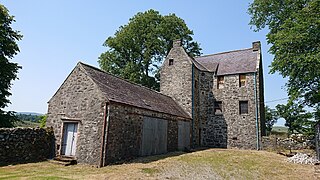
Earlstoun Castle, sometimes spelled Earlston Castle, is a derelict tower house near St John's Town of Dalry in Dumfries and Galloway, Scotland. Built in the late sixteenth century, it was home to members of the Gordon family, including William Gordon of Earlston who was killed at the battle of Bothwell Bridge. It is unusual for a tower house of its age for its lack of defensive arrangements: it has no gun loops, its roof is without a parapet or corner turrets, and it lies in open ground without natural defences.

Rutherford's Monument is a commemorative monument between Anwoth and Gatehouse of Fleet in Dumfries and Galloway, Scotland. It is dedicated to the 17th-century theologian Samuel Rutherford, who had been minister at the nearby Anwoth Old Church. It was built in 1842, and takes the form of a granite obelisk atop a square base. It was badly damaged by lightning in 1847, and rebuilt in 1851. It is a Category B listed building.











